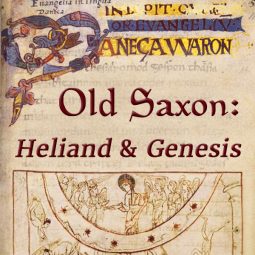INSTRUCTORS:
Prerequisite: At least one of the following is a prerequisite: Introduction to Old English, Beowulf in Old English, Introduction to Germanic Philology I, Introduction to Germanic Philology II, or instructor permission.
The Old Saxon language serves as a useful bridge between Old English and the continental West Germanic languages like Old High German and Old Low Franconian (Old Dutch). However, the language is often understudied in the English-speaking world due to its continental origin, and too often has fallen into the “German-only” branch of study within Germanic philology. Old Saxon preserves a remarkable 9th-century literary poem known as the Hêliand (that is, the Savior), a long, syncretic reworking of the Gospels into a style of Germanic alliterative verse usually reserved for heroic poetry. Similarly, the poem fashioned much of the Gospel narrative into a more familiar Old Saxon cultural milieu, in some ways transforming Christ and his disciples into a Germanic chieftain and his thanes. The surviving manuscripts are fairly easy to read, and there will be considerable attention paid in this course to learning how to read the texts from the original manuscripts. In addition to the Hêliand, parts of the Old English poem Genesis were originally composed in Old Saxon, which scholars labeled Genesis B (the bulk of the poem was labeled Genesis A), and fragments of the original Old Saxon text have survived. The Hêliand and Genesis are the only survivors of the unique poetic output of Old Saxon, and excerpts of both texts will be studied in depth in this course.
This course has a prerequisite, though a slightly flexible one, and is designed to be taken after at least one semester of Old English or Germanic Philology, and assumes familiarity with translating related Germanic languages (especially medieval forms of West Germanic languages, such as Old English or Old High German). The coursework most heavily involves preparing translations of Old Saxon texts into modern English, followed by reading secondary scholarship. The overall aim of the course is to acquire advanced reading knowledge of the Old Saxon language, particularly through the Hêliand and Genesis.
Weekly Schedule
This language seminar includes two live 1.5-hour discussion sessions per week as assigned (3 hours total weekly).
Course Schedule
Week 1 –The Historical and Linguistic Background
Read: Cathey, pp. 1-15, 263-292 (‘Historical Setting of the Heliand’, ‘A Brief Outline of Old Saxon Grammar’); Robinson, pp. 100-135 (‘Old Saxon’)
Translate (121 total lines):
- Robinson, “Lord’s Prayer” and “Parable of the Sower and the Seed” (Old Saxon)
- Heliand, excerpt 1 (lines 1-85a)
Week 2 – Introducing Heliand
Read: Murphy, ‘The Old Saxon Heliand’
Translate (210 total lines):
- Heliand, excerpts 2-3 ([89 total lines] lines 119b-158; 192a-242)
- Heliand, excerpts 4-5 ([121 total lines] lines 243-329a; 339-374a)
Week 3 – The Manuscripts of the Heliand
Read: Cathey, pp. 16-28
Translate (239 total lines):
- Heliand, excerpts 6-8 ([135 total lines] lines 386b-426; 503b-531a; 536b-603a)
- Heliand, excerpts 9-10 ([104 total lines] lines 630-654; 699b-779)
Week 4 – When and Where
Read: Price, ‘Authorship of the Heliand’ (pp. 25-49)
Translate (267 total lines):
- Heliand, excerpts 11-13 ([156 total lines] lines 873-948; 977b-993; 1020-1085a)
- Heliand, excerpts 14-15 ([111 total lines] lines 1121-1202a; 1248b-1278)
Week 5 – Old Saxon Verse-forms
Read: Lehmann, ‘The Rhythm of Old Saxon’ (in The Development of Germanic Alliterative Verse Form)
Translate (264 total lines):
- Heliand, excerpts 16-18 ([140 total lines] lines 1279-1380; 1381-1419)
- Heliand, excerpts 20, 22-26, ([124 total lines] lines 1667b-1686; 1741-1750a; 1771-1801a; 1801b-1826a; 1837b-1855a, 1873b-1880a; 1915-1916a, 1940-1956)
Week 6 – The Heliand as Verse
Read: Hartmann, ‘The Old Saxon Heliand: Working Through Ambiguity’
Translate (283 total lines):
- Heliand, excerpts 27-29, ([124 total lines] lines 1999b-2066; 2124b-2149a; 2180b-2212a)
- Heliand, excerpts 30, 32-34 ([159 total lines] lines 2231b-2283; 2474-2513a; 2580b-2620; 2728-2756)
Week 7 – The Heliand and Its Sources
Read: Haferland, ‘Was the Heliand Poet Illiterate?’
Translate (249 total lines):
- Heliand, excerpts 35-39 ([136 total lines] lines 2773-2799a; 2899-2931a; 3066b-3092a; 3122b-3151a; 3200a-3223a)
- Heliand, excerpts 40-43 ([113 total lines] lines 3295a-3374; 3444b-3475; 3522-3540; 3588b-3630)
Week 8 – Religion and Peoples in the Heliand
Murphy, ‘The Jews in the Heliand’
Translate (277 total lines):
- Heliand, excerpts 44-48 ([139 total lines] lines 3683b-3705; 3992b-4002a; 4045b-4064; 4065-4117; 4121b-4157)
- Heliand, excerpts 49-51 ([138 total lines] lines 4278b-4285a, 4308-4335, 4352-4377; 4494b-4521a; 4575b-4627)
Week 9 – Spelling Variations in Old Saxon
Read: Boutkan, ‘The Solution of the Old Saxon Auslaut Problem’
Translate (285 total lines):
- Heliand, excerpts 53, 56-57 ([148 total lines] lines 4810b-4903a, 4913b-4923a; 5111b-5130a; 5144b-5170)
- Heliand, excerpts 63-65 ([137 total lines] lines 5487-5511a; 5532-5592a; 5621-5674a)
Week 10 – New Discoveries
Read: Schmid, ‘A New Heliand Fragment from the Leipzig University Library’
Translate (281 total lines):
- Heliand, excerpts 65 (cont.)-67 ([115 total lines] lines 5674b-5712; 5713-5741a; 5761-5810a)
- Heliand, lines 5810b-5984 (incl. Leipzig fragment; [174 total lines])
Week 11 – The Old Saxon Genesis
Read: Doane, The Saxon Genesis (excerpts from the Introduction)
Translate (363 total lines):
- Old English Genesis B lines 790-816; Genesis, lines 1-150 (176 total lines)
- Genesis, lines 150-337 (187 total lines; it is expected that some of the later lines will bleed into Week 12)
Week 12 – Shorter Texts in Old Saxon
Read: d’Alquen & Trevers, ‘The Lay of Hildebrand: A Case for a Low German Written Original’
Translate:
- Baptismal Vow
- Worm-charm
- Bede Homily
- Lay of Hildebrand (Is this an Old Saxon poem in part?)
Required Texts
The Amazon links are provided for convenience only, and we encourage students to purchase the text wherever they wish.
Further required readings will be provided in class.
Optional Text: Murphy 1995, The Saxon Savior: The Germanic Transformation of the Gospel in the Ninth-Century Heliand
Course History
This course has been offered in the following semesters.
| Semester | Preceptor(s) |
|---|---|
| Spring 2022 | Dr. Paul Peterson & Dr. Nelson Goering |



